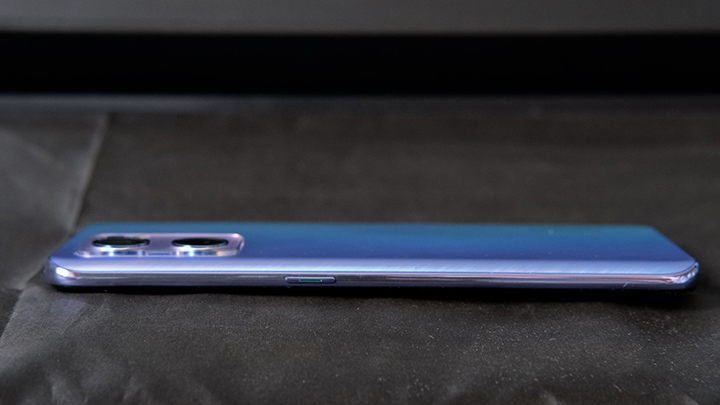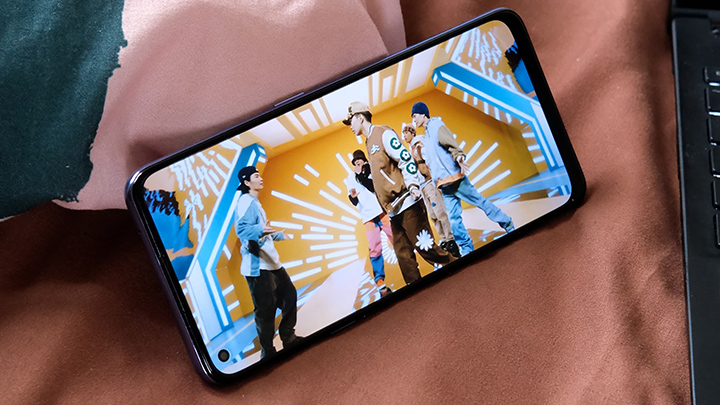With the release of two new Reno smartphones, namely the OPPO Reno7 Z 5G and the Reno7 5G, OPPO yet again set the bar of the premium mid-ranger devices. In this video, we are focusing on the Reno7 5G which possesses an AMOLED screen, triple rear cameras, and a MediaTek Dimensity 900 chipset. We spent some quality time with this device and although there were a few drawbacks, it was overshadowed by its advantages over some of the smartphones in its class. If you want to know more about it, continue reading.

Table of Contents
Let’s get down to the nitty-gritty. The design of the Reno7 looks stunning most especially the back panel as it shimmers and changes color depending on the angle of the lighting which will definitely turn heads. Found on the upper left corner is the protruding camera setup which makes the camera lens an illusion as if it was floating on a piece of glass. The back also has this frosted glass texture so it’s very effective in repelling fingerprints and smudges.

The unit we have is in the Startrails Blue colorway but it also comes in Starlight Black if you want a less flashy design aesthetic.
We have a sizable 6.4-inch AMOLED panel and situated on its upper left side of the display is the selfie camera, and right in the upper bezel is the earpiece. It’s got thin bezels all around and a THICCC chin.

When it comes to buttons and ports, starting on the left side, we have the triple card tray for two nano-sized SIM cards and a dedicated microSD card slot, as well as the volume buttons.

Meanwhile, on the right side we have the power/lock button.

USB-C port, 3.5mm audio jack, main microphone and speaker grilles at the bottom, and the secondary microphone at the top.
When it comes to ergonomics, even though the Reno7 5G has a tall form factor, all buttons are easily reachable as they are all placed near the middle of the frame. So for those folks who have smaller hands, fret not as you can reach these buttons with ease. Also, it feels very light at 173g and thin.
For display, the front sports a 6.4-inch FHD+ AMOLED panel with a 90Hz refresh rate with a resolution of 2400 x 1080 with a pixel density of 409ppi. The display comes protected with Corning Gorilla Glass 5 and a pre-installed screen protector which is always nifty. The display quality is what you would expect on an AMOLED panel, it produces vibrant colors with deep blacks and is viewable even under direct sunlight as it produces up to 800 nits of peak brightness.

On the display settings, you can adjust the temperature of the display to cool, default, or warm which is always a helpful feature to reduce eye strain. There are also dark mode settings that let you set how dark you want to go.
For refresh rate, you can opt to use it on the high refresh rate, drop down to 60Hz to conserve battery life.

Audio quality is OKAY, it’s basically what you would expect on a mid-ranger. You get a single downward-firing speaker which sounds tiny and definitely lacks bass. It is not really ideal for watching content but will suffice for speaker calls. We do recommend you use your favorite wired headphones as it comes with a 3.5mm audio jack, or a pair of good-sounding TWS if you have one for a more optimal viewing experience.
When it comes to the cameras, it has a triple-lens setup which consists of a 64MP main, 8MP ultra-wide, and a 2MP macro lens. While we have a 32MP selfie camera.
Photos from the main camera come a little muddy in low light scenarios, details, and colors can be washed out. Things can get a little better in good lighting conditions with good color accuracy, though, there are instances where the photo lacks sharpness. But in all fairness, the main sensor can produce a well-balanced exposure which sometimes is hard to achieve on other devices on this tier.
Since there is no telephoto lens, we rely mostly on the main camera for digitally zooming on a subject. And the images were okay, with little to no details.
Portrait on the other hand, background and subject separation can be a little too sharp, especially in the hair area, but overall, it does look decent and the blur effect looks somewhat natural.
We did enjoy taking macro photos as you can get closer to the subject with ample detail, and color reproduction looks natural.
When it comes to selfies, skin tone can be soft and looks much more refined thanks to a subtle beautification that is taking effect in post, as for HDR, the background can be washed out in overly bright scenarios.
Overall, the images produced by the Reno7 5G are decent and are acceptable for casual social media postings, stories, and that sort.
For videos, the Reno7 5G can record a maximum resolution of 4k at 30FPS, but the ultra steady mode is only available for the 1080p resolution. Video quality is excellent as it has vibrant colors and sharp details.
Running on the Reno7 5G is Android 11 skinned with ColorOS 12. You can have the option to use navigation keys or gestures as well as the app drawer option if that’s what you prefer. There are tons of customization options here where you change icon styles, app layout, fingerprint animation, change font and colors, and edge lighting. You can check it under the personalization category in the settings.

You also get an always-on display wherein you can use OPPO’s own customizable animated emoji called the Omoji and there’s also a portrait silhouette option which we also saw at realme 9 Pro Plus. Which is fun to play with by the way.

And like usual ColorOS versions, it comes with a few bloatware and tons of pre-installed apps like Netflix, Facebook, TikTok, Twitter, Messenger, Lazada, and Agoda which can be removed after setup.
Out of the 256GB of storage, we have 230GB left which is ample for most users, but if you think you need more storage, there’s a microSD card slot in the mix.
For biometrics and security, there’s facial recognition and an in-display fingerprint scanner. Both work as intended, but we highly recommend you use the fingerprint scanner instead for a higher level of security.
Under the hood, the OPPO Reno7 5G packs a MediaTek Dimensity 900 5G with a Mali-G68 MC4 GPU. It comes with 8GB RAM with 5GB RAM expansion, and 256GB of UFS 2.1 storage. The device performs excellently in doing basic day-to-day tasks such as browning the web, opening all social media apps, binge-watching content on Netflix, and more. Although there are noticeable lags and frame drops in some animations when switching apps.

When it comes to gaming, playing casual 2D games are good, we didn’t experience any lags which is the total opposite when playing graphically intensive games such as Asphalt 9, Genshin Impact in maximum graphics settings, though it can still be playable, we suggest lowering the graphics level down to the lowest possible for it to be much more optimized and for a smoother experience.
Check out the benchmark scores that we got:

When it comes to connectivity, the OPPO Reno7 5G includes WiFi 6, Bluetooth 5.2, GPS, NFC, Dual 5G connections, and USB Type-C. For battery, this device sports a 4,500mAh battery with support for 65W fast charging and reverse wired charging. It can last you a whole day if you are not a heavy user, but if you turn on your cellular data most of the time, play graphically intensive games as well as do heavy multitasking, expect it to last half a day which can easily be remedied by the 65W fast charging capabilities as it can juice up this device from 0-75% in a little over 30 minutes which is fast.
In our PCMark Battery Test, the devices lasted 15 hours and 45 minutes which is not spectacular but a bit above average.

Overall, the OPPO Reno7 5G is a solid contender in the mid-range space, but is it any better than most of its competitors? It sure is, since the OPPO Reno7 packs a nice display, decent cameras, and one of the highlights is the 65W fast charging capability, with all of that, still we have to consider the price. At the price of PHP 26,999USD 460INR 39,003EUR 438CNY 3,351, OPPO should really place this well-below PHP 20K to be really competitive.
OPPO Reno7 5G specs:
6.4-inch FHD+ (2400 x 1080) AMOLED display, 409 PPI
90Hz refresh rate
180Hz touch sampling rate
Corning Gorilla Glass 5
MediaTek Dimensity 900 5G
Mali-G68 MC4
8GB LPDDR4x RAM (+5GB RAM Expansion)
256GB UFS 2.1
microSD card slot (dedicated)
Triple rear cameras:
• 64MP F1.7 (main)
• 8MP F2.2 (ultra-wide)
• 2MP F2.4 (macro)
32MP F2.4 front camera
Dual 5G
Dual-SIM (nano)
WiFi 6
Bluetooth 5.2
GPS, Beidou, GLONASS, GALILEO, QZSS
NFC
Fingerprint scanner (in-display)
USB Type-C
ColorOS 12 (Android 11)
4,500mAh battery w/ 65W fast charging, reverse wired charging
160.6 x 73.2 x 7.81mm
173g
Starlight Black, Startrails Blue

YugaTech.com is the largest and longest-running technology site in the Philippines. Originally established in October 2002, the site was transformed into a full-fledged technology platform in 2005.
How to transfer, withdraw money from PayPal to GCash
Prices of Starlink satellite in the Philippines
Install Google GBox to Huawei smartphones
Pag-IBIG MP2 online application
How to check PhilHealth contributions online
How to find your SIM card serial number
Globe, PLDT, Converge, Sky: Unli fiber internet plans compared
10 biggest games in the Google Play Store
LTO periodic medical exam for 10-year licenses
Netflix codes to unlock hidden TV shows, movies
Apple, Asus, Cherry Mobile, Huawei, LG, Nokia, Oppo, Samsung, Sony, Vivo, Xiaomi, Lenovo, Infinix Mobile, Pocophone, Honor, iPhone, OnePlus, Tecno, Realme, HTC, Gionee, Kata, IQ00, Redmi, Razer, CloudFone, Motorola, Panasonic, TCL, Wiko
Best Android smartphones between PHP 20,000 - 25,000
Smartphones under PHP 10,000 in the Philippines
Smartphones under PHP 12K Philippines
Best smartphones for kids under PHP 7,000
Smartphones under PHP 15,000 in the Philippines
Best Android smartphones between PHP 15,000 - 20,000
Smartphones under PHP 20,000 in the Philippines
Most affordable 5G phones in the Philippines under PHP 20K
5G smartphones in the Philippines under PHP 16K
Smartphone pricelist Philippines 2024
Smartphone pricelist Philippines 2023
Smartphone pricelist Philippines 2022
Smartphone pricelist Philippines 2021
Smartphone pricelist Philippines 2020